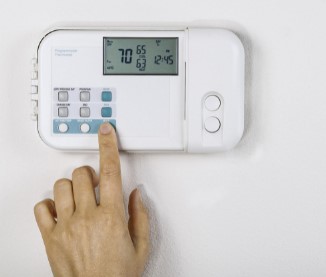Choosing Between ON and AUTO for Your HVAC Fan Settings
Are you wondering about the best way to cool your home without wasting energy? This often comes down to the big question of using ON mode versus AUTO mode on the fan that’s part of your home’s heating, ventilation, and air conditioning (HVAC) system. However, there are pros and cons to know about both options that will impact your comfort level inside your home. Take a look at everything you’ve ever wanted to know about choosing between your HVAC system’s ON mode versus AUTO mode fan settings.
What’s the Difference Between ON and AUTO on Your HVAC System?
The fan setting that you see on your cooling system’s thermostat controls is responsible for controlling your system’s blower. The blower is an essential component because it’s responsible for circulating hot and cold air through the system until the number you’ve selected as your “ideal temperature” on the thermostat is attained. As you may already know if you’re researching this topic, the fan has a setting for using either ON or AUTO mode. What does each option mean?
AUTO refers to a setting where the fan turns on automatically whenever your system is heating or cooling the air inside your home. That means that it turns off on its own once your thermostat reaches your desired temperature. By contrast, ON means that your system’s fan will constantly remain in the “on” position to blow air at all times.
Is there a recommendation for which option is better? Generally, the decision to use either ON or AUTO is considered one of personal preference. However, both options have pros and cons that homeowners should know about. Next, dive into the important pros and cons when deciding between ON and AUTO for your HVAC fan.
The Pros and Cons of Putting Your HVAC Fan on AUTO
The biggest reason why many homeowners select the AUTO option is that it’s the more energy-efficient option of the two. In addition to being good for the environment, the AUTO option can potentially help homeowners to save a noticeable amount of money every month.
There’s another perk to the AUTO option that may actually create a more comfortable environment. AUTO creates better humidity control when compared to ON. While this may seem counterintuitive, it begins to make perfect sense once you understand how an air conditioner takes the humidity out of the air. During the cooling cycle, the air in your evaporator coil moves around in a way that forms droplets. AUTO mode actually activates a warming process that will direct these droplets out of your home through the drain pan. The result is lower moisture levels in your home!
Are there any cons to using the AUTO option for your home’s cooling system? Yes, there are some downsides to choosing this option. Here’s what you need to know about the cons of using AUTO:
- AUTO can sometimes reduce the distribution of air in a home. This happens because the fan stops circulating air through the home once it shuts off.
- Some people find that their blower motors wear out faster as a result of the constant “stopping” and “starting” that will happen with AUTO mode.
- If your home has a filtration or UV light system, the AUTO setting may prevent air from staying as clean as it would using the ON setting.
The big takeaway with the AUTO setting for your system’s blower fan is that this is generally considered to be the more environmentally friendly option. You’ll also generally see a lower energy bill compared to a household with a fan in the ON setting.
However, some people find that using the AUTO setting prevents even air distribution that would create maximum comfort in a home.
The Pros and Cons of Putting Your HVAC Fan on ON
Is the ON setting the ticket to smooth sailing with your HVAC system? One of the biggest benefits of consistently keeping your fan in the ON setting is that you can avoid the constant “stop” and “start” cycle created by the AUTO setting that could potentially overtax your system. You may even be able to avoid repair bills by sticking to the ON setting.
There’s also the benefit that the ON setting generally creates a more comfortable indoor environment by promoting more even air distribution throughout a home. The ON setting helps to prevent those notorious hot and cold spots that sometimes happen with inconsistent airflow. However, that doesn’t mean that the ON setting is the perfect option for every home. Here’s a look at the cons of using the ON setting for your fan:
- Homeowners should anticipate higher energy costs when they decide to stay with the ON setting. Your system will be using much more energy to keep the fan running when compared to the AUTO setting that only runs the fan when your system is heating or cooling.
- Homeowners should also be aware of the fact that the ON setting can increase humidity levels in a home. The AUTO setting has a dehumidifying effect because it allows for moisture droplets to have time to be directed away from the home when the fan isn’t running. This isn’t the case with the ON setting. In fact, both relative humidity and dew point can be expected to go up in a home with the fan on the ON setting. This can offset the benefits of even heat distribution that cause many people to choose the ON setting. In addition to making your home less comfortable, higher humidity levels put your home at greater risk for mold. In general, homeowners should be monitoring moisture levels to ensure that readings are reaching a relative humidity level above 70%.
- Keeping the fan on the ON setting can also clog your air filters quickly. While this isn’t a big deal, it will require you to be more vigilant about making sure filters are being changed regularly. The reason why filters get dirty faster with the ON setting is that the fan is continually pulling in household air from the vents. A continuously running fan is simply going to pull more dirt in during a shorter period when compared to a sporadically running vent.
- Finally, there’s also the potential for keeping the fan on the ON setting to contribute to air duct leakage. Why is this? About half of the leakage that occurs in a home happens as “return air” cycles through the duct system. If your fan is continuously blowing air, you’re simply bound to lose more of your conditioned air. This means a direct loss of energy.
The bottom line on using the ON setting for your fan is that it’s likely to do a better job of creating even heat distribution in your home. You’re also saving your system from the stress of constantly having to power up and down when the fan is triggered. However, the ON setting also wastes more energy than the AUTO setting. There’s also the added concern about your home becoming too humid when the ON setting is used continuously.
Finding the Right Settings for Your HVAC Fan for Energy Savings in Newark, Delaware
The one thing that rings true regardless of which setting you chose for your fan is that a properly maintained, highly efficient HVAC system is the best option for enjoying a comfortable indoor air temperature without wasting money. That’s why the team at Delaware Heating & Cooling Service in Newark is here to answer all your questions about keeping your HVAC system in optimal condition. We can also give you some tips on choosing the right setting based on the specifics of your household. Contact us today!


Recent Comments